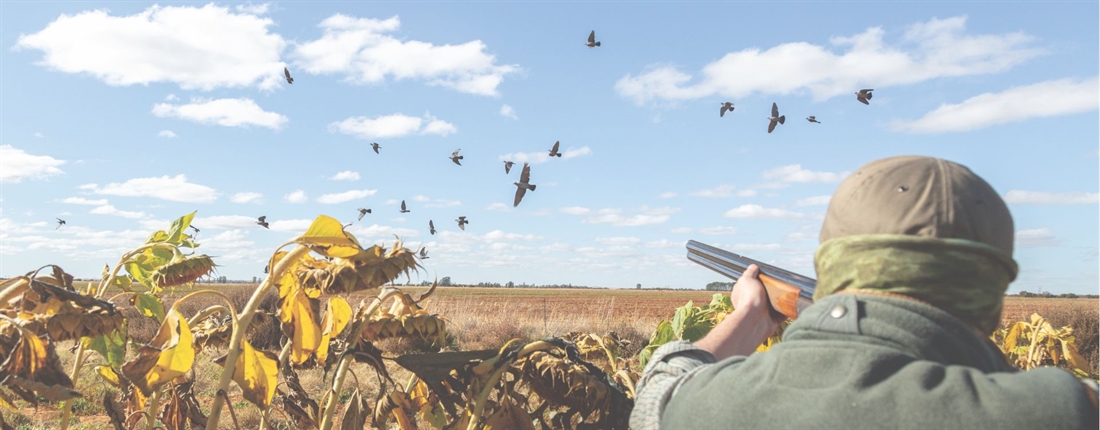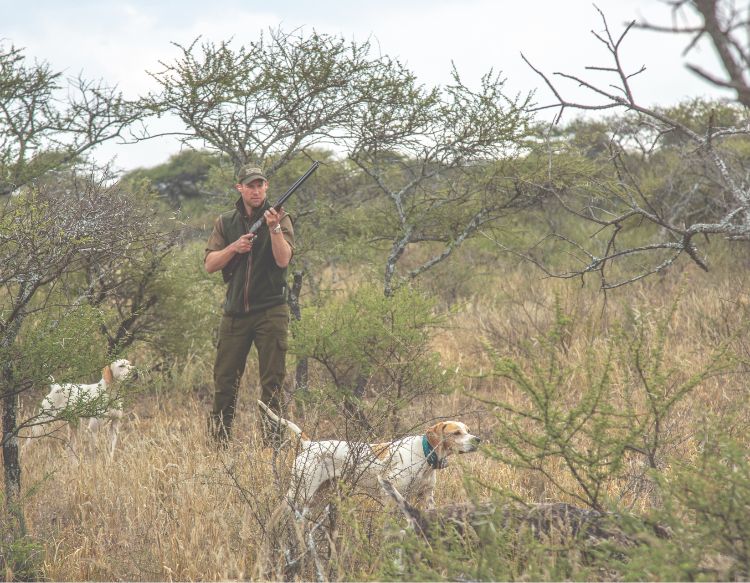Every shot in the book
Seven days, three provinces, 12 species ... An African bird shooting safari not to be forgotten.

I’d always imagined my first sporting sortie on African soil to involve a rifle, not a shotgun. And yet here I was, the sharp, white spines of acacia whipping past the window of the Cruiser as our party made haste to intercept a flock of helmeted guineafowl, pockets stuffed with No. 5s.
We were in classic bushveld country, north of Polokwane in the Limpopo. Wary and wily, the first quarry of our bird hunting safari – the likes of which none of us had experienced before – were doing their very best to set the tone for what would be an exhilarating week.

The pursuit of guineafowl is as much about finding them and driving them as it is about raising one’s gun. The unpredictable nature of these gregarious icons of the African bush ensure that you don’t take a fruitful encounter with them for granted. They are wild and vigilant – to become absorbed in the successful manoevring of a big flock over a line of Guns is par for the course, especially when you feature in that line. Forget the garden-dwelling birds you’ve seen mixing it with chickens at manor houses back home; wild ‘guineas’ are sharp of eye, use the wind, and find gaps in a line like a fen pheasant, albeit in a slower, lower and more deliberate fashion. Mystifying aerobats they are not, but I challenge anyone not to be excited by the raucous cacophony that ensues when, roused by the beaters, they launch their plump bodies into the air and proceed to flow over the Guns in great numbers.
We also had the chance to walk and shoot. Weaving amongst the euphorbia, prickly pears and termite mounds, it was anybody’s guess what might appear. Mousebirds, hornbills, namaqua doves and lilac-breasted rollers flitted and floated past, warthogs and grey duikers bolted out of hiding places ahead, and every so often one of the pointers would freeze, lift its paw and gaze intently at cover close by…
Sometimes the dogs would pick up the scent of game that had run on; other times francolin – Swainson’s and crested – or miniscule button quail would explode in ones, twos and small coveys from the white grass as one of our team walked in to the point. Adrenaline-spiking stuff.
Flirting with a pleasant 20°C, the temperatures – typical of June – made walking quite bearable, even in the noon sun, yet the cold beers served by Robbie and James on the tailgate at the end of each day were most welcome. We missed some, we hit some, we laughed at one another each time we stopped for refreshments on the hoof; it was in good spirits that we made our way back to the lodge each evening, watching the dust kicked up by the trucks’ massive tyres turn orange in the glow of the setting sun, pockets full of empty shells.

The spur-winged goose (Plectropterus gambensis) is the largest species of wildfowl in Africa, related to geese and shelducks but distinct from both in a number of anatomical features. On average it is considered the world’s largest wild ‘goose’ – it has a wingspan of up to two metres and can weigh up to 9kg . Where food is aplenty, they often join the throngs of Egyptian geese which descend on recently harvested crops – in this case, maize. They are surprisingly quiet in their approach – a quiet, high-pitched whistle and a rush of air through pinions was sometimes the only warning we had as we crouched down in the camo-net blinds, surrounded by sunflowers. To shoot them is quite a special experience.
We’d travelled south from our first stop to a place where flat, featureless and vast landscapes stretched away from us in every direction. The Freestate – the bread basket of Africa – would be our home for a few days, our quarry now a whole new ball game. It was cold – frosts are not uncommon in the winter months of June, July and August – so it was with several layers of clothing and a glut of anticipation that we arrived in the blinds before dawn.

Fold-out decoys were arranged in the adjacent field, its centre-pivot irrigation unit threatening to soak them later in the morning, but few birds decoyed to the pattern. More often we’d rise from our positions as both species of geese flighted this way and that, circling widely, eager to drop into the field. The spur-wings would spot the slightest movement with ease, tip a wing, reroute just out of range, whilst their beautiful Egyptian cousins, with their pastel plumage and bolder nature, comprised the bulk of sport enjoyed.

We called time before the flight dried up entirely, and searched the crop, row by row, for the fallen. As the sun climbed in the azure sky, and those layers of clothing were removed, I already wanted to do it again. But a new challenge beckoned…
Think late October grouse x woodpigeon, throw in a bit of pace and agility, and you have the South African rock pigeon, Columba guinea.
We first saw them skimming low and with purpose across the wavering sea of yellow-petalled sunflower heads. We were lunching early, watching as the avian traffic built… and built… and built… just a few hundred yards away. Flocks streamed above our vacant hides which were invisible from the dining table. A fine spread it was, too, but we ate without thinking about food; all eyes were on the busy horizon. It was late morning by the time we were in situ, peering through the hide netting, trying to pick a bird out in front before rising carefully so not to send them into a swirling, flailing, confounding tangle of wings and flared tails. The adrenaline flowed, hearts raced – it was fast and furious action.
The breeze stiffened as the day aged, forcing them lower still, barely above head height. With average flight speeds of 55mph, the rockie has the ability to turn even the most nimble of Shots inside out – and tie them in knots in the process. Picking a bird and sticking with it is key. That’s for the first shot, and it’s easier said than done. For the second shot, you’re on your own…
Amongst the rockies were Cape turtle doves. Similar to those found in South America, they stood out due to their distinct tameness by comparison; it’s a bit like comparing a blue wildebeest to a Cape buffalo. Indeed the rockie has much in common with the latter bovine: the challenge of shooting them becomes infinitely harder once they have spotted you, and you need sound shot placement to get the job done with the first cartridge; these birds have an uncanny ability to maintain momentum for a long way on one wing.

Gradually the return flight began in earnest and it made sense to turn the blinds around. These birds were different altogether. From sporting to silly-high, they flew home at a height any Devon valley gamebird would aspire to, and the style of shooting changed completely: less instinctive, more calculated, more time with the gun in the shoulder – weight on the back foot now. Plooms of feathers drifted on the wind up high as laughs and cheers carried on the breeze. What an incredible day it had been.
The thought of leaving the Freestate behind might just have been too much if it wasn’t for our final destination. “There’s much more to see,” James and Robbie had assured us as the trucks gobbled up the tarmac, heading south. After five gluttonous days of impala, springbok and eland steak dinners, biltong galore and ad lib Windhoek, we’d need to find our hill legs. “What you will experience over the next 48 hours is widely regarded as Africa’s ‘Champagne’ sport.”
James was referring to walked-up greywing francolin shooting in the Stormberg Mountains. But he’d have been equally within his rights to be describing the afternoon’s snipe shooting we enjoyed on the lower ground with its lush green bogs – a game of straight lines, sharp eyes and reflexes – or one of the evenings spent in the natural reed hides flighting yellow-billed ducks and teal against the winter sunset.
The greywing francolin (Francolinus africanus) typically lives on montane scrub and grasslands at an altitude of at least 1,500 metres above sea level. It doesn’t look dissimilar to a pheasant poult crossed with a grey partridge, and the bulk of its diet, certainly in the Stormberg Mountains, consists of monocotyledonous bulbs; indeed these bulb-producing plants are essential for sustaining large numbers of the species.
“We’re careful only to shoot 40 per cent of what we have here each year,” explained Robbie whose family have owned the Stormberg conservancy for 190 years, farming Merino sheep and offering some of the very best plains game hunting in the Eastern Cape to boot.
This isn’t a numbers game. It’s about watching the deepchested pointers quarter the ankle-breaking terrain, taking in the arresting landscape, appreciating the wildlife, and, every now and again, an encounter with a covey of greywings.
Dassies bolted between their rocky burrows, a black eagle worked the thermals lazily overhead and a cohort of Cape mountain zebra came dangerously close to the dogs, trotting unpredictably by the end of our line.
Greywing coveys range in size from three or four to 20 birds, and they often sit very tight, sometimes lifting in ones or twos rather than all at once. They’re well-camouflaged and can run if a point is not followed up hastily. And then the challenge of shooting them: finding a steady footing, anticipating the direction of the flush, establishing a line and marking success…
It was a week of variety, of pulse-quickening frenzies in the hide, hot barrels, impossible angles, quivering dogs, evenings around fires, sunsets and meaty meals. As our party gathered around the table at Buffelsfontein Lodge on the final evening to taste the snipe we’d bagged earlier that afternoon, a myriad of taxidermy watching over us, I wondered quite how many people might – like me – have overlooked this most special of bird shooting destinations. I’m already yearning to return…
IF YOU WANT TO GO
Bird Hunters Africa have access to some of the most beautiful and prolific areas with accommodation to match. They offer flexible bird shooting safaris with species pursued and the extent of travel optional.
The best time to go is April to August. Shotguns can be supplied with prior notice. Cartridges are available to purchase separately.
Marcus Janssen is hosting another trip with Bird Hunters Africa in June 2019. For more details email marcusjanssen@icloud.com
admin@sesafaris.com
Author and photographer Will Pocklington
Related Articles
Get the latest news delivered direct to your door
Subscribe to Fieldsports Journal
Elevate your experience in the field with a subscription to Fieldsports Journal, the premium publication for passionate country sports enthusiasts. This bi-monthly journal delivers unparalleled coverage of game shooting, fishing and big game across the UK and beyond.
Each issue offers a stunning collection of in-depth features, expert opinions and world-class photography, all presented in a timeless yet contemporary design.
Save 10% on shop price when you subscribe, with a choice of packages that work for you. Choose from Print & Digital or Digital only with each journal delivered directly to your door or via the app every other month, plus access to past issues with the digital back issue library.







